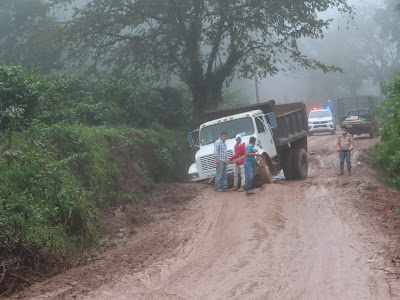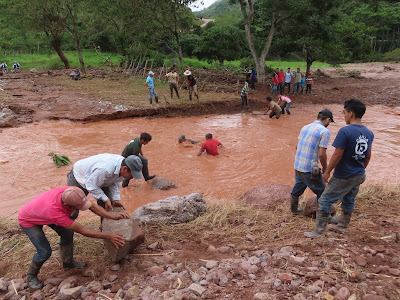This year we have seen more rain than usual here in Honduras – and this was even before the two hurricanes that hit.
We have had a few days of sun and heat after Hurrican Iota, but now forecast is for more rain. This, I believe, will provoke more problems for the people, especially in our area.
In the wake of the first hurricane, ETA, there were landslides in several aldeas, with a number of people losing the houses. One community, San Marcos Las Pavas, has been cut off since the first hurricane.
When Hurricane IOTA struck, there were more landslides with tens of houses destroyed and scores severely damaged. In a few places, houses were washed down the side of a hill. In one case. A family escaped their house when a huge boulder fell and rushed their house and buried. Their possessions, even some stored grains. In at least five communities there are parts of the aldea that are in extreme danger. The people will probably have to relocate and build in safer places.
The first hurricane produced several landslides that prevented passage in a few places, but Hurricane ETA’s rains made some parts of the parish almost completely inaccessible. Many communities were cut off when roads collapsed due to landslides or the rain-soaked soil.
The roads were in bad condition before hurricane ETA due to heavier rains than usual and the lack of maintenance. The soil here is very slippery when it rains and if gravel has not been put down it’s treacherous. In addition, the ruts in the roads have only gotten worse. In addition, in at least one place, the river washed away half the road.
In one part of the parish, a road was collapsing and, even though some work was done on it after Eta, it was impassible in the wake of Iota.
To get to some areas, you had to go on a roundabout route which at one time meant passing three times through a stream and navigating a slippery incline.
In another part of the parish, which includes about 16 aldeas, landslides prevented access for several days. One aldea was cut off from Hurricane Eta until yesterday.
In another place there was no access even from the major road on the other side of the parish that goes between La Entrada and Copán Ruinas. A bridge which had fallen about three years ago and had never really been repaired or rebuilt, collapsed; but even more, the road the led from the bridge, with access to two villages, was washed away by the river.
Two days in a row I was stopped at the same point on the road into Dulce Nombre. The first day a large dump truck had gotten stuck in one of these ruts and had to be pulled out by a bus. The bus was a former US school bus, perhaps the one that has Minnesota plates. The next day a bus got stuck in the same place. Finally, some work was done yesterday to make the spot more passible.
Many of the roads have been repaired, but access to some aldeas is still precarious. I also think that the repairs area only stop-gap measures.
Electricity was off in many communities for days. In addition, service for one of the cell phone companies was unavailable for days, leaving people isolated and without communication.
Many communities which had water systems were affected by the hurricanes. Some of them were able to restore water service in a few days. Some didn’t have water for long periods. Some still don’t.
Here in Plan Grande, water was restored yesterday, after almost two weeks without water. I have a tank for water and collect rainwater in four barrels (which are now full). But I conserved water – using rainwater as well as dirty water from washing clothes (by hand) to flush toilets. But there are still at least three fairly large communities who still have not been able to restore their water systems. A few smaller villages still don’t have water.
An aside: much of the water for the water systems in rural villages comes from springs in the mountains. The source is often miles from the village, brought in by tubing to tanks in the communities. Tubes, even metal tubing, were moved by the landslides and the settling of the soil and so had to be replaced or reconnected. It’s a difficult job, not only because of the distances but because of the mud.
One of our first priorities in the parish has been making sure people re safe and providing them with food and other necessities.
Many people here in Honduras have been generous and provided help – food, clothing, blankets, and donations.
Some people in Dulce Nombre have provided aid and donations have arrived from family members of people from the parish who are now in the US and Spain. A few days ago, 30 some boxes of supplies arrived from Santa Rosa, a gift from the Association of Hondurans in Madrid, Spain.
Sunday, we picked up 180 bags of goods plus clothing and blankets donated by a group in Tegucigalpa.
But getting to the communities has been difficult.
I got out to Vega Redonda November 19. People were afraid that a landslide which stopped at one point would come down and bury much of the town. Several had lost their houses; others left their houses fearful that they be destroyed by a landslide or be inundated by the rains and mud. Some people left and found refuge with relatives in Dulce Nombre and Concepción.
November 19, we went to Vertientes, on the side of a mountain. The town is split into two parts, by a huge landslide that destroyed three houses and left at least three in danger. Padre German and Fernando, a seminarian with us this year, went to see a distant part of the village where another landslide had buried houses and even a car.
On Thanksgiving I went with three other cars loaded with provisions and clothing to aid two distant communities in the parish - San Marcos las Pavas (Saint Mark the Turkeys) and Barbascales. San Marcos has bee isolated since ETA. At least five houses were destroyed, many have serious damage, and probably close to half the houses are at risk if there are future landslide or sinkholes. We had to go to La Entrada to get there, making it close to two hours. We couldn't get to the village because the bridge (which was in poor condition) had collapsed. In addition, the land that went from the bridges to nearby roads was washed out. While we were there a number of men were trying to put rocks in the river so that people could pass over.
Last Saturday, I went with several others to take basic supplies and clothing to four villages. We could see where the landslides had closed the road in several places.
We couldn’t get to the fourth village because a landslide was being cleared away and we couldn’t pass. We did, however, leave provisions for five families there who had been identified as particularly affected. They managed to send someone to pick up the supplies.
On our way, we could see some of the damage to coffee crops.
On the way back, I passed over this sunken part of the road near the cemetery in Delicias, Concepción. It sank because the cement drainage pipe was falling into the hillside.
Right now, we have supplies in the parish which we hope to get to the communities when we can arrange the delivery. The problems are numerous – the roads, the lack of electricity in some villages that makes communication by cellphone difficult (because of batteries running out), and more. But we will keep trying.
Thanks be to God, up to this moment, there have not been any deaths in our parish from the hurricanes.
What the future holds is difficult to discern. There will need to be massive efforts to restore the infrastructure – particularly water systems, electricity, and road. There are houses that need to be rebuilt in safer places. There are portions of at least five villages that need to be assessed because of the ongoing risks. The people may need to relocate and build in other areas. That will be a long-term project.
In the meantime, please pray for us and, if you can, find ways to help.

























No comments:
Post a Comment